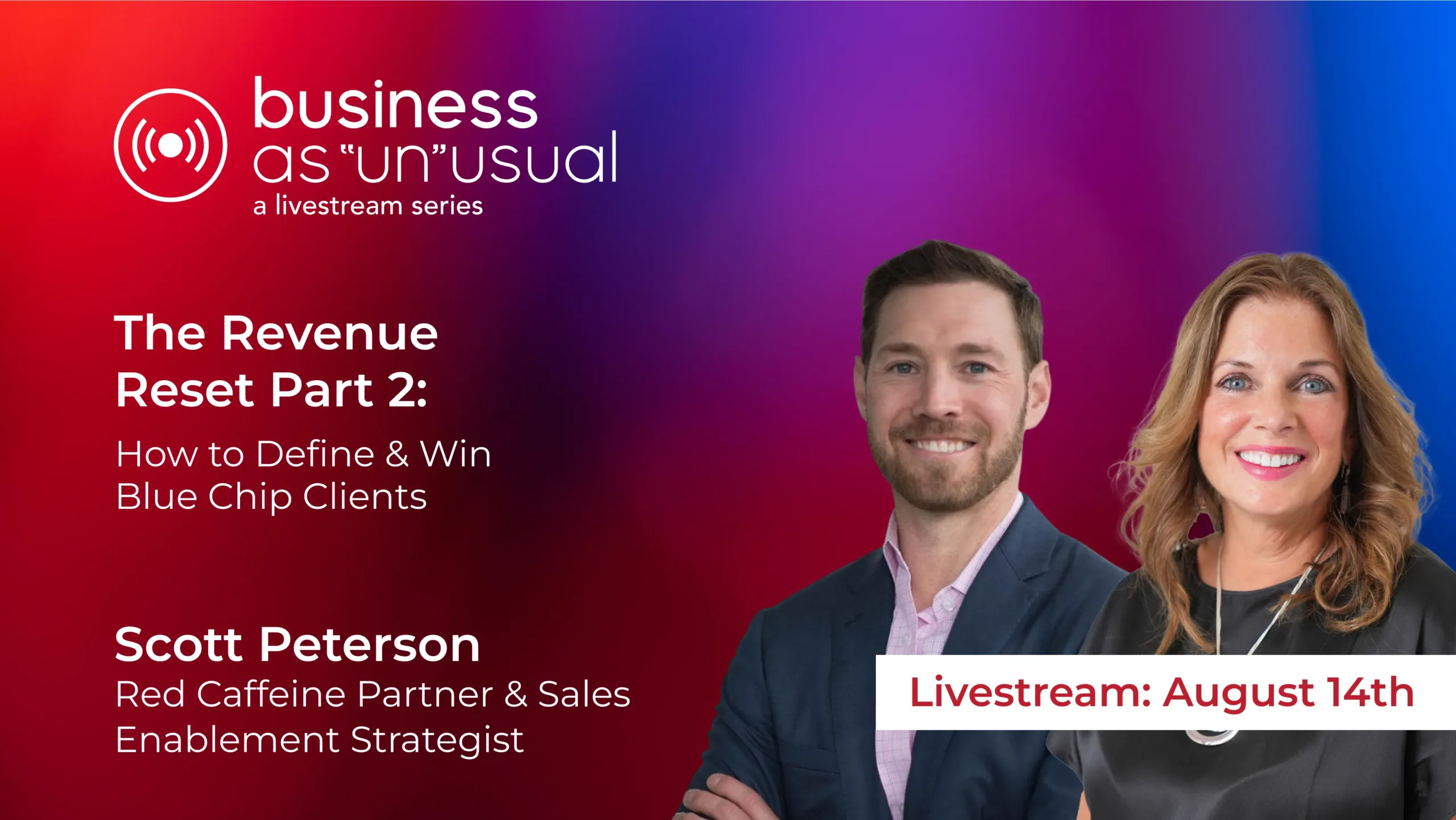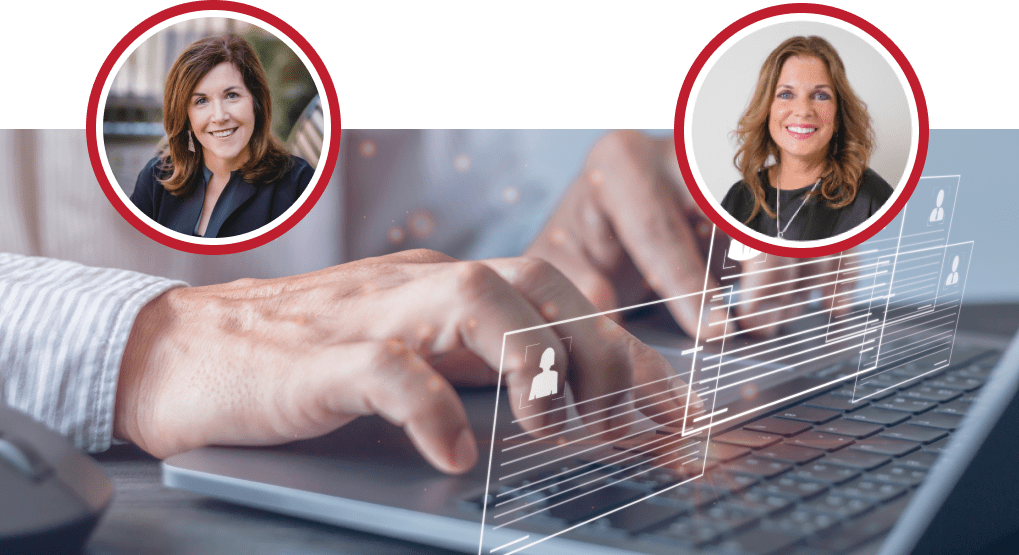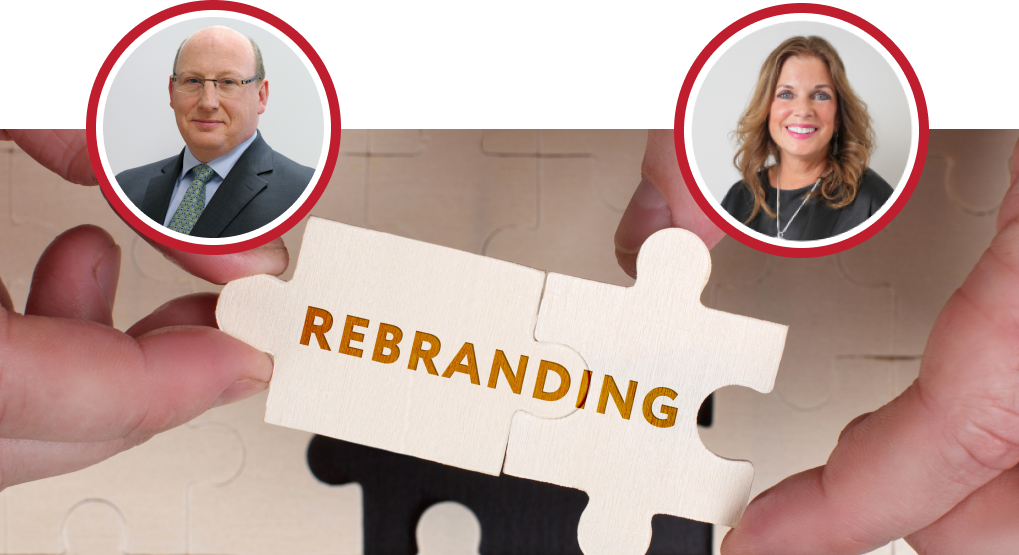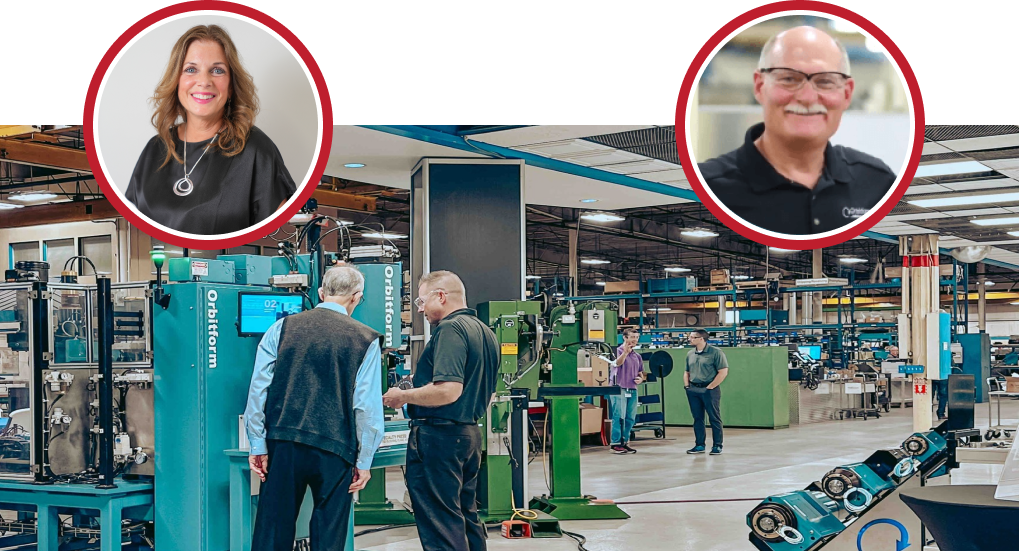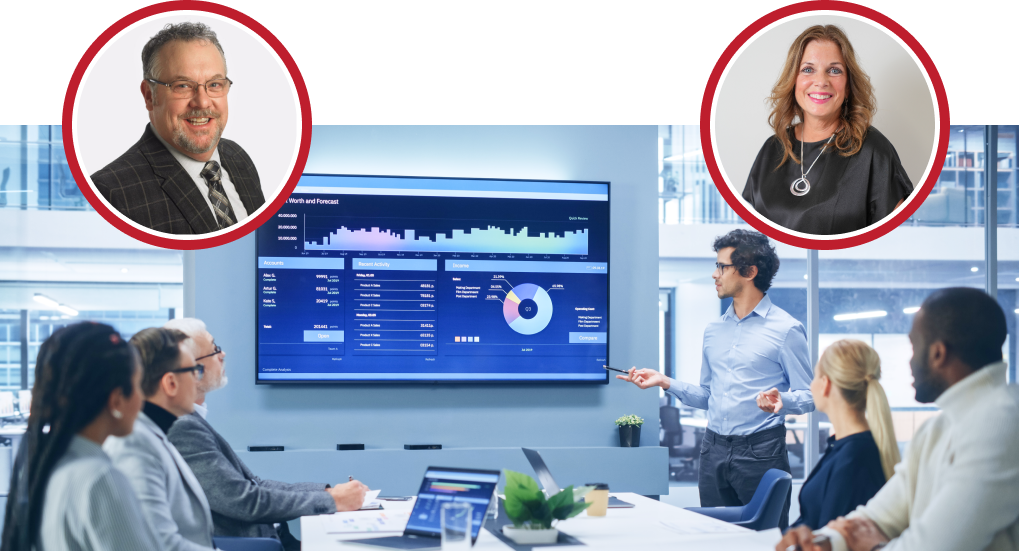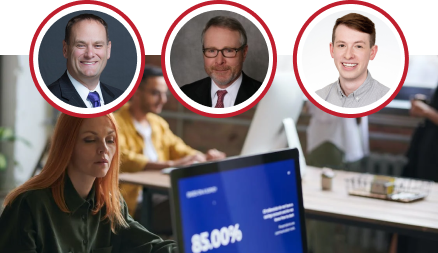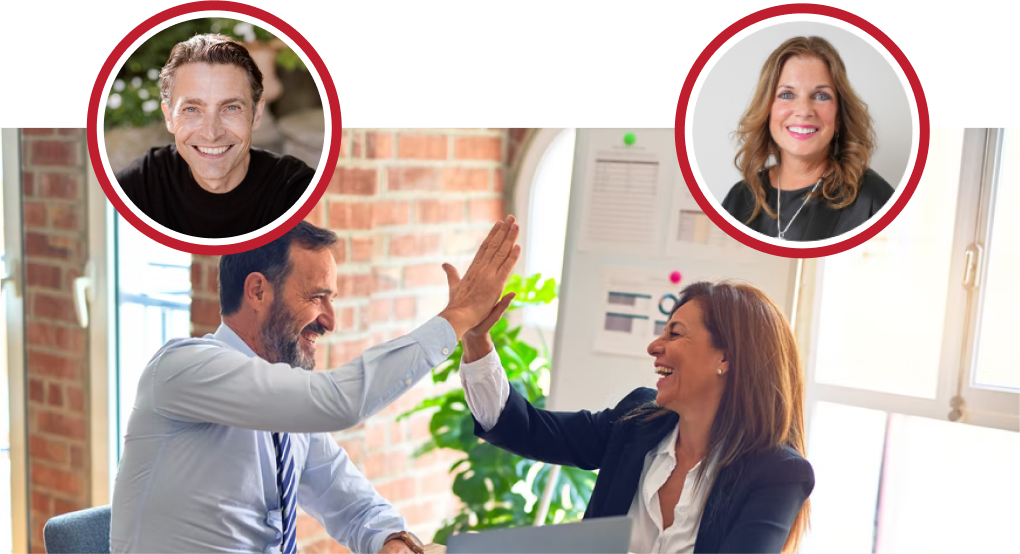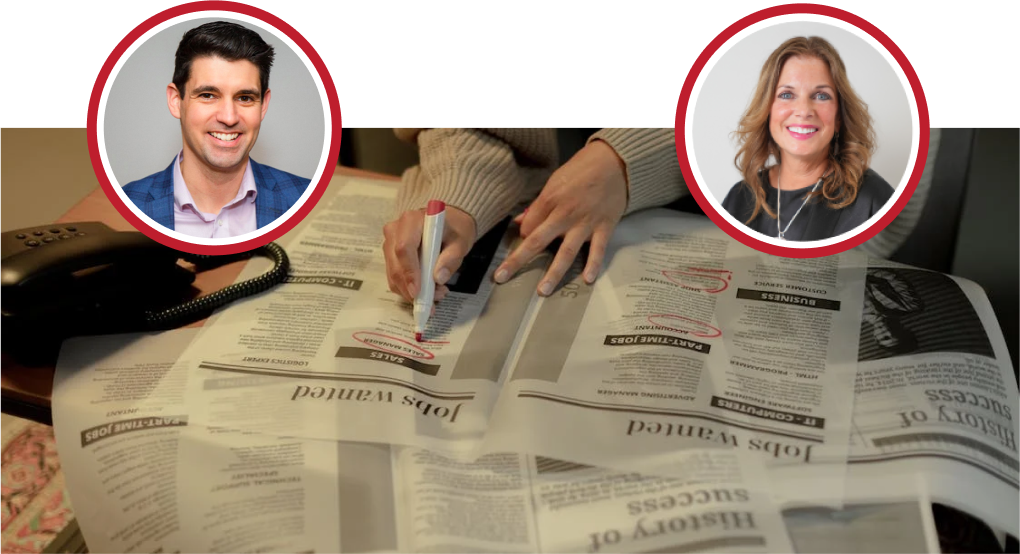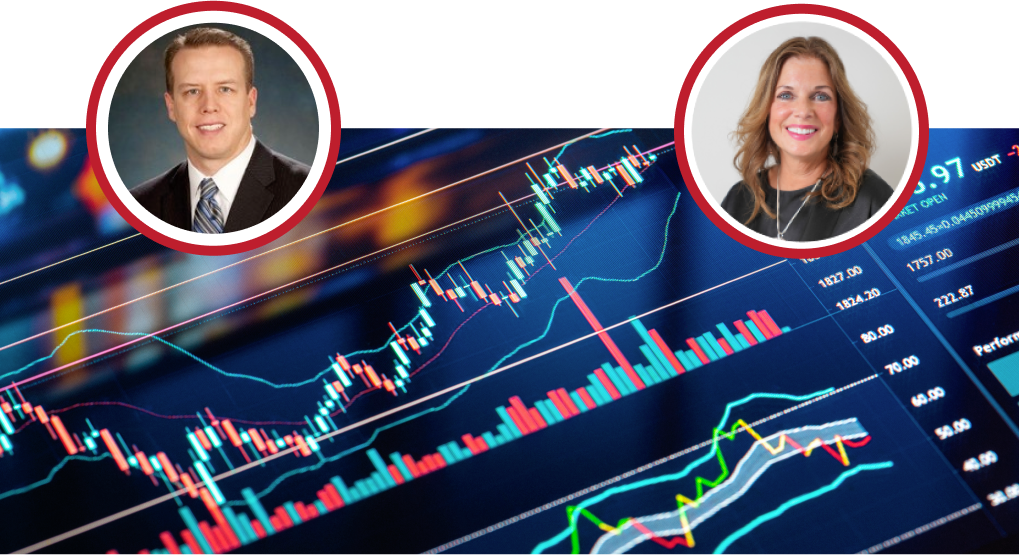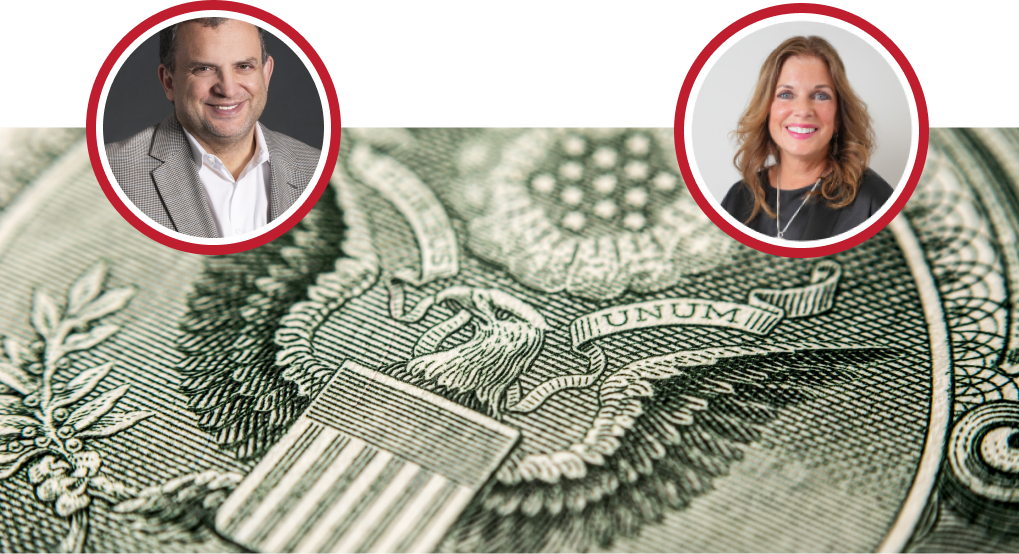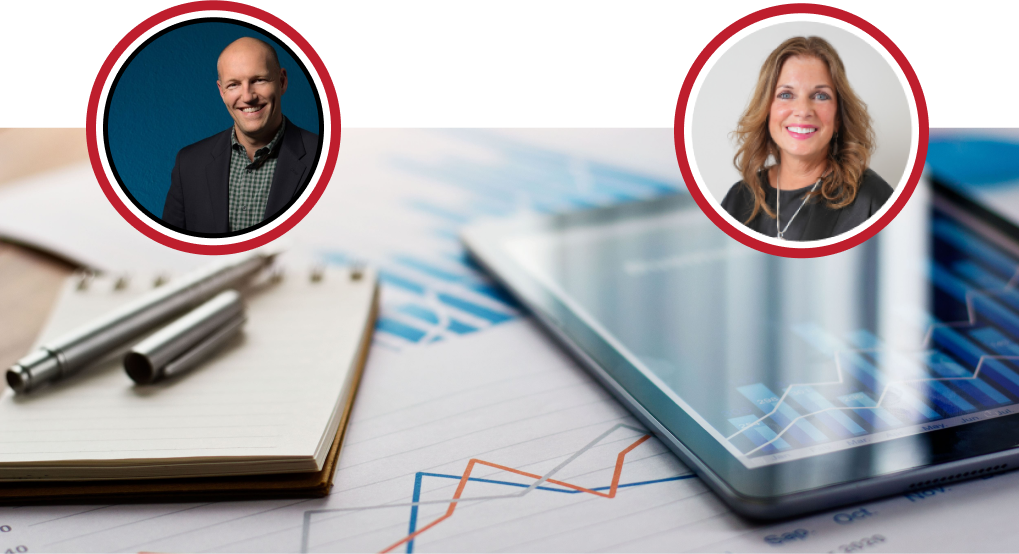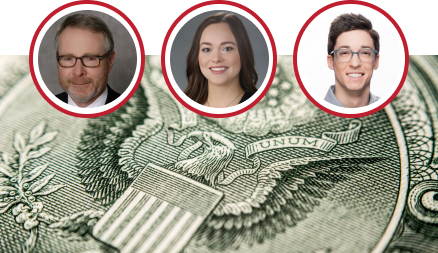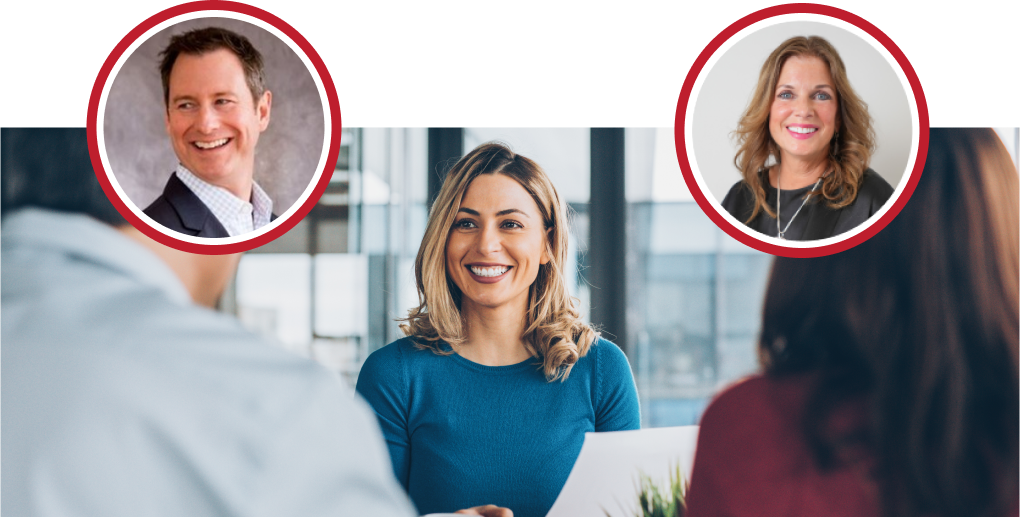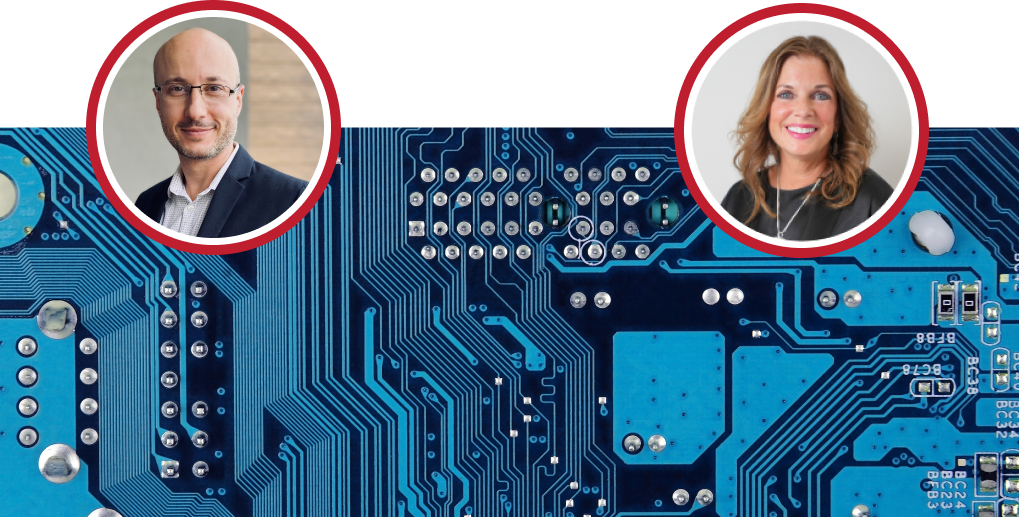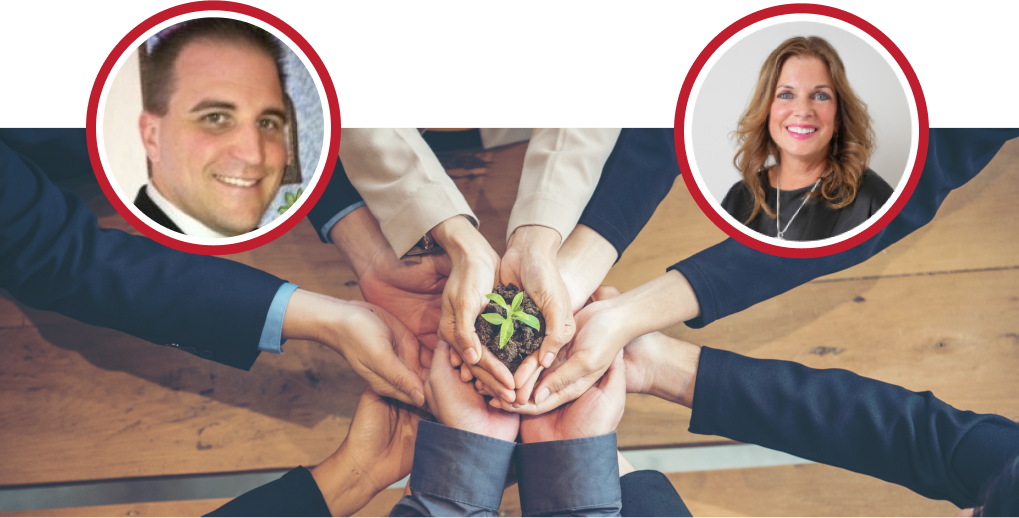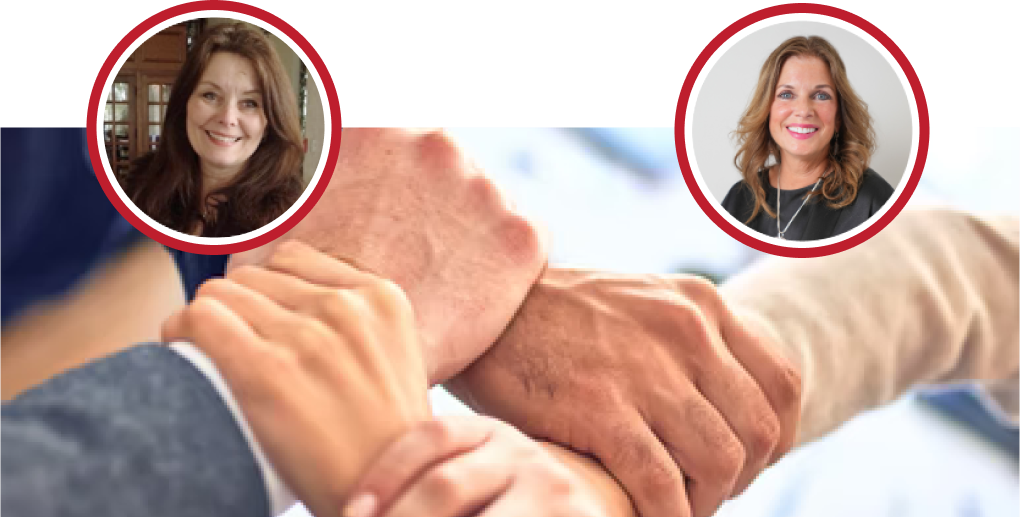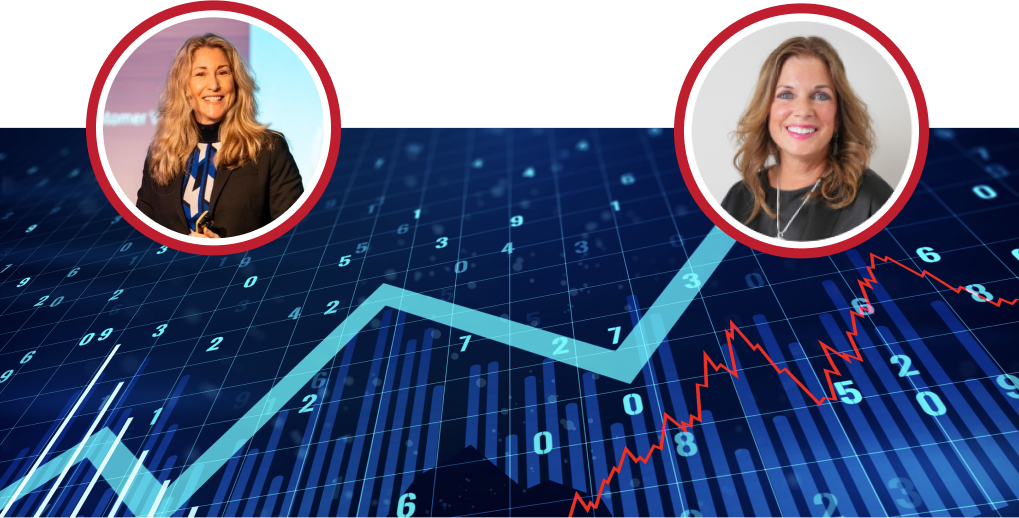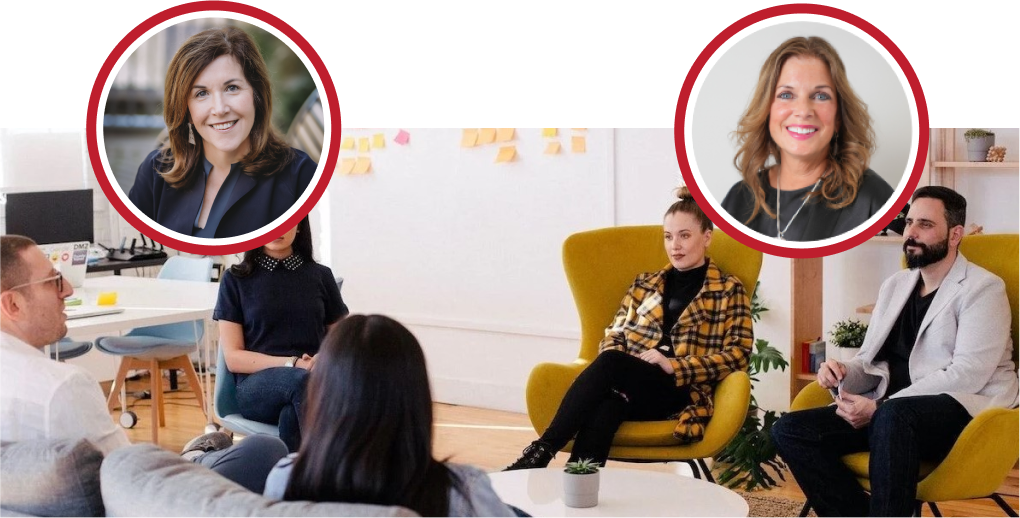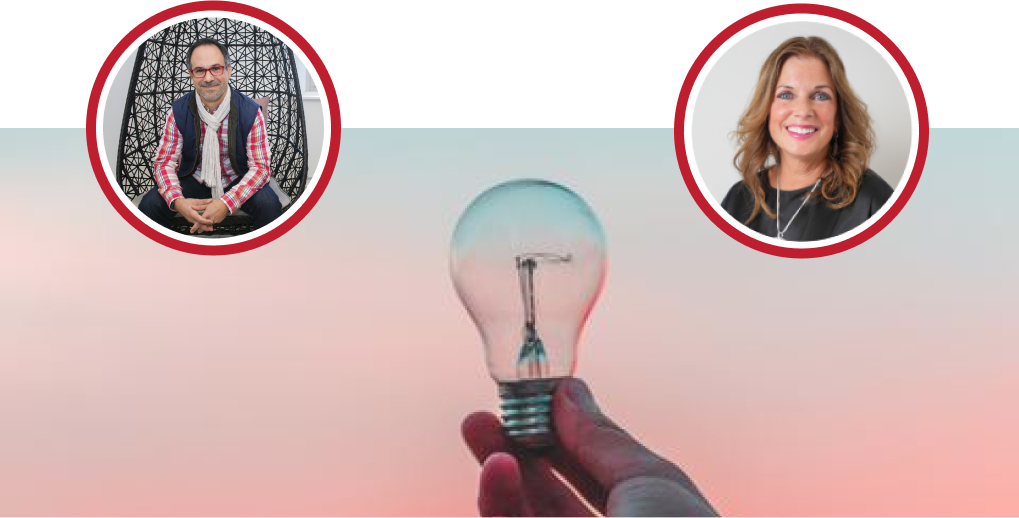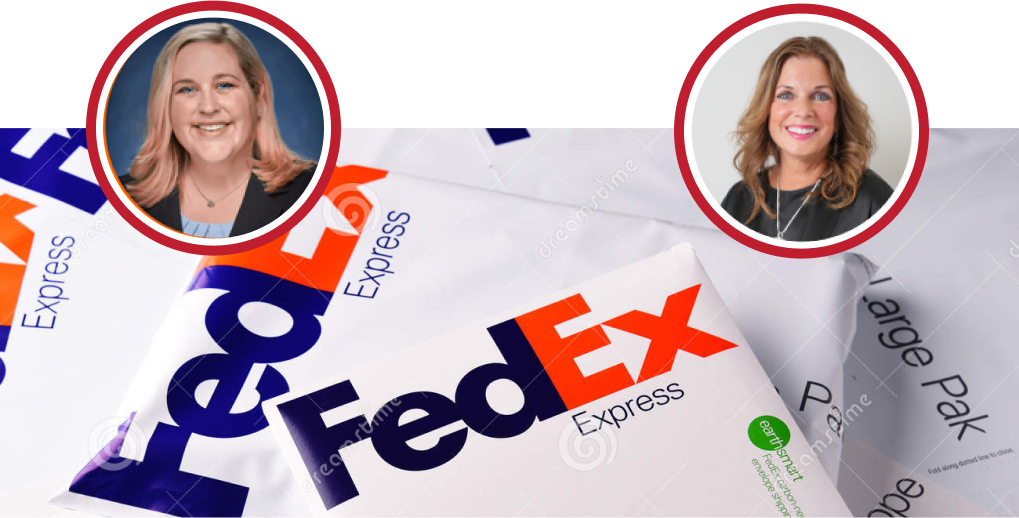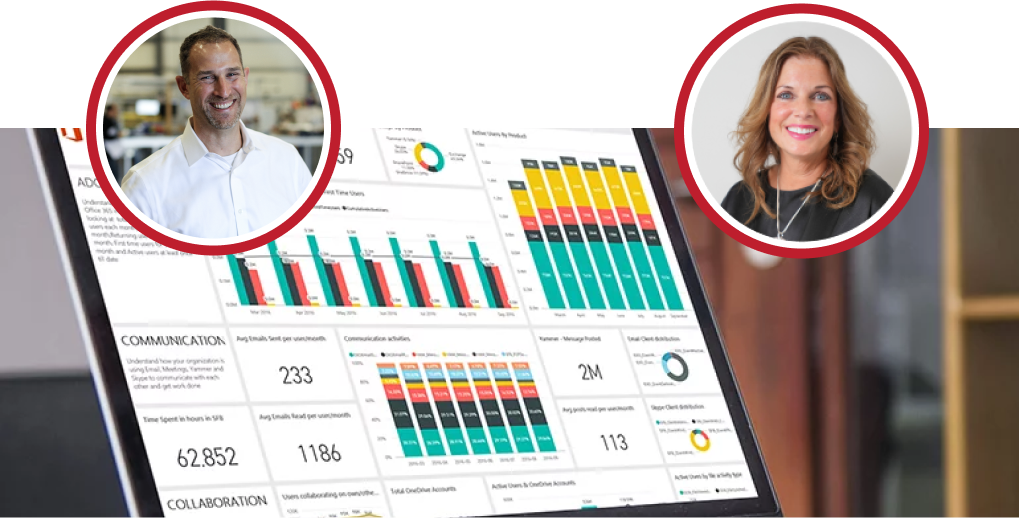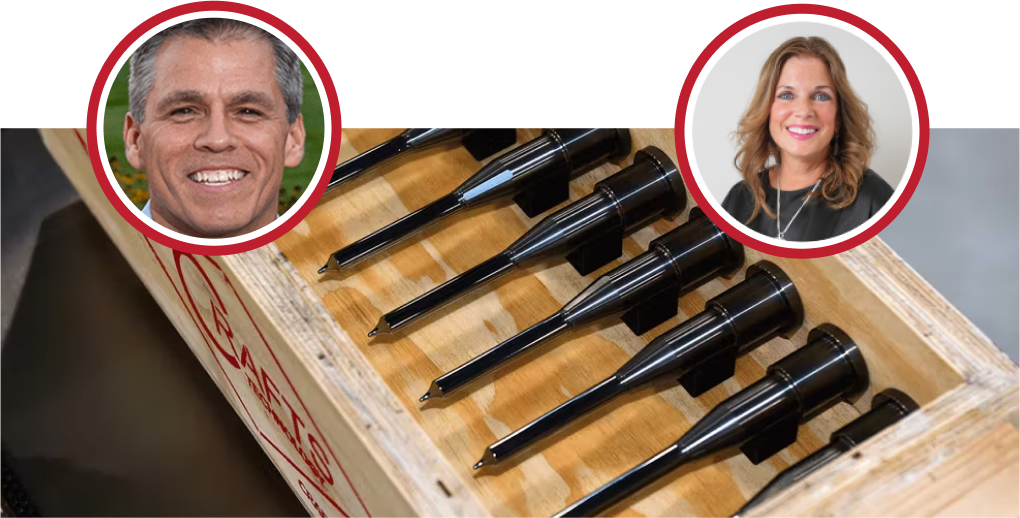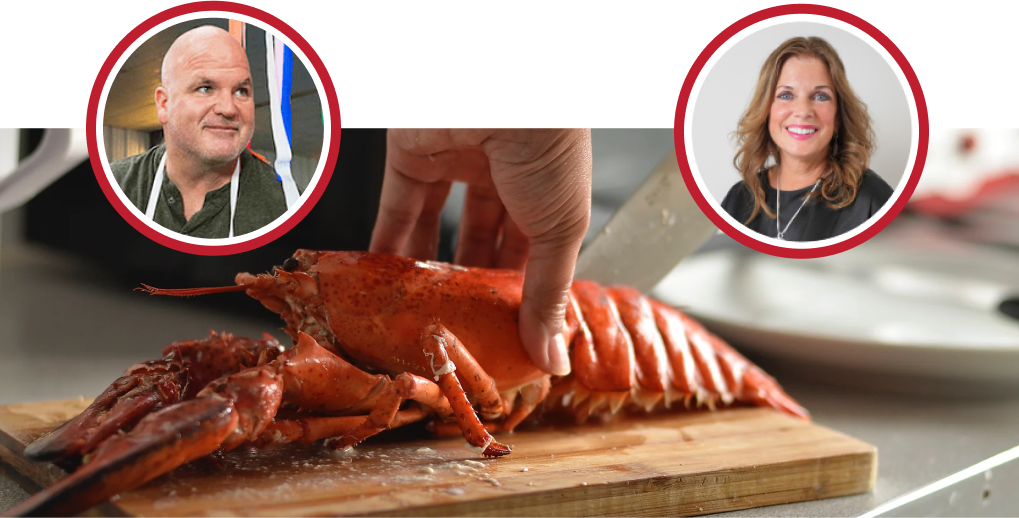Lisa: And again, we are excited to have everyone here with us for our “Business As Unusual” webinar. Hard to believe we’ve been doing these now for over a year as we look back on 2020 and all of the changes, but as we look ahead, we are excited to have our guest speaker Eric Berggren, with us today. So, officially let’s go ahead and welcome everyone to our “Business As Unusual” webinar series, where we’re speaking with badass industry leaders who are helping us survive and thrive in today’s business climate. My name is Lisa Behning, I’m one of the Account Directors at Red Caffeine, and I’ll be your moderator for today’s session in addition to being joined by Red Caffeine’s Founder and C.E.O., Kathy Steele. As I mentioned before, we’re excited to have Eric Bergeron, Managing Partner and Founder of Axioms Partners, with us today. A little bit about Eric is actually on the board at Scott Ford, which is the leading open dive forge in North America. He also sits on the marketing faculty at Northwestern University’s Kellogg’s School of Management, and in his role at Axioms Partners, he actually helped found the company that’s focused on really the customer value strategy and how you bring that into producing results, not only for your business but for your customers. So, we’re excited to dig in on today’s session, where Kathy and Eric are going to be exploring how to shift your focus from features and costs to more of a value you’re providing your customers; it’s really a different way to think it’s more profitable to run your business, and we’re going to cover a lot of ground here in the next 45 minutes to give you everything you should be considering as you move forward with this type of business model few housekeeping pieces we do have everyone on mute today. So, I encourage you to please use the chat function you can also use the Q.A. option as well to ask questions, and Kathy and I will be watching and monitoring those throughout today’s session to feed those to Eric as appropriate, and we’ll also get to questions at the end as well as we’ve been doing with all of our “Businesses As Unusual” webinars, the first five registrants have received a 25 or excuse me a 20 Grubhub gift card to purchase lunch at one of their local area restaurants. We know how hard-hit the restaurant industry has been over the last year. So, it’s just our small part in helping those businesses survive as well, so thank you to Suzanne Catherine, Tony Ira, and Randall, who were our first five registrants; you should have received your gift card last night, and if not feel free to reach out to me. So, with that being said, let’s go ahead and dive into today’s topic, and I will welcome Kathy and Eric officially to the floor. So, good afternoon everyone, and let’s get started.
Kathy: Thanks so much, Lisa and Eric. We are just absolutely thrilled to have you with us today and excited to dig into this topic, so why don’t you just give us a little bit? Lisa gave us that top-line view of your background but told us a bit about your career journey and how you got here?
Eric: I was a strategy consultant at a strategy boutique originally, and I got assigned to do a strategy for a natural gas producer, and I thought, well, this is going to be pretty fast because natural gas is a commodity, and we all know that it’s all about cost and getting your prices low, and you make a lot of money if you’re the low-cost provider but we instead we went out and talked to a number of their customers about 50 of them actually, and we identified about half the market there were some other things you could do for them besides just providing that molecule of methane, and they were able to differentiate their offering they increased their spot their profitability their profit margins by 40, and they jumped from the bottom quartile and customer satisfaction all the way up to number two out of 100 and some. So, it was at that point I thought, well, maybe there is something to this customer value idea and looking at it in terms of value instead of just the product, and I’ve really spent the rest of my career focused on helping companies innovate the value that they deliver and then manage it for both growth and in profitability.
Kathy: That’s so, seems sort of contradiction to be able to charge more and have happier customers. So, excited to hear more about that. So, we always talk about the different growth lines. We focus on really nine different ways to grow a business with our client base, and pricing just underpins the entire process. So, I’m just anxious to have you kind of get down and start to explain what does this mean? What is customer value management? What does customer value leadership? Sort of give us just that baseline understanding.
Eric: Yeah, so, the customer value management really focuses on getting that deeper understanding of value on multiple levels and then literally managing the business based on that value. I wanted you to switch over to the next slide, please. Lisa, oh, I’m sorry, the next one, yeah, the next one. So, it’s all about figuring out what that value is and then making all your business decisions based on the knowledge of that value, and what that helps you do is to both grow because you’ve got more value, but also there’s a lot that you can be doing with your company without it with those insights to manage your profitability a lot better and a lot of people come on these webinars to promote their own book I’m here to actually point you to somebody else, if you really want to see the really kind of the definitive work in customer value management my colleague James Anderson wrote this book, and while it, he did write it a little bit ago it’s still even more relevant today in terms of, so if you’re looking for some further reading on this after our webinar I would recommend you check out both of these two things. So, let me start with a story here. So, if we’re really going to manage value, we need to really understand it at a much deeper level and I had a client, and I don’t know whether you’re going to be able to see this, but this is a what is a Petri dish it looks like a Petri dish well I had a client that made contact plates which are basically these Petri dishes, but they put some chemistry in there. So, when you put your sample, and it automatically starts to react to something, and then you can kind of see what it is, but they made these it was pretty much commodity business because no matter whose contact plate you bought if you were Eli Lilly or Pfizer you had to react exactly the same way otherwise you wouldn’t know what the results were, so they had embarked on a cost reduction strategy, and they came up with a way of lowering the manufacturing process, but it made the lid here really sticky so if you get it off, but you had to kind of pinch it and twist it a little bit to get it off, and they thought this was going to slow the operator down in the lab and what that meant is they were going to have to lower their price. So, it’s a ten manufacturing savings. So, they could lower their price by five percent and share the savings 50:50 with their customer, and they were feeling pretty good about this because that five percent in a commodity market is a big discount, but it turns out that when we went, and we analyzed what happened in the lab at Eli Lilly. Well, they would stack these contact plates 10 or 20 high on the lab bench, and then they’d invariably fall over, the lid would come off, and they’d have to redo the test they might have to resample they have in any kind of any anything that happens out of the ordinary in a lab you have to fill out a report so when you started adding up all of these costs it turns out that the cost of dropped contact plates was over 50 percent of the amount they were spending on the contact plates themselves so instead of lowering the price by five percent we raised the price by 20, and they still exceeded their volume targets. So, it’s one of these things where the key foundation for customer value management or any of these kinds of experiences is to dive deeper into what value is, so Lisa, why don’t you move on to the next?
Kathy: So, let me do it. Let me ask a quick question, Eric, so; it sounds like you really had a deep dive into the customer experience. So, a better understanding of how they were using those Petri dishes, those contact containers sort of under unveiled. What was the value? So, that’s pretty interesting.
Eric: Right, so it was really more of an ethnographic or observational kind of marker research technique, and in that situation, it is really helpful because if we ask them what do you want in a contact plate, they say, well, we want it to react the right way, and we want it as cheap as possible because these things are commodities. So, you’re not going to get that suggestion likely get that suggestion from the customer. You’ve got to go there, observe it and kind of develop it yourself. That’s a great point, so if we’re going to talk about value, let’s first talk about what it’s not because we see this a lot. So, it’s not about us or our products or our features. We’ve all heard the features the benefits lecture, but I don’t know about you, Kathy, but I’m still amazed at how many you look at marketing materials, how many marketing materials are still just feature-laden, and even I’ve got students in class where I show them this slide and say don’t talk about features they present a project, and it’s all features so because yeah features are differentiators, but they’re not motivating to actually make the purchase all they are is something that’s different. So, we need to if you’re looking at value statements, and it’s just a list of features about us that’s not really going to be a deep enough dive into what the value is the opposite extreme, are these feel-good statements. So, oh, they cut buy from us because of the relationship or high quality or complete solutions. My favorite now is one, the complete one-stop solution right, so now everything is actually a solution right because your problem probably saw your product probably solve some problem for your customer that’s why they’re buying it. So, everybody can claim a solution, and now we spend all our time tacking on adjectives or adjectives onto that to try to make it more differentiating, but the fact of the matter is the solution of any kind really isn’t differentiating. So, I mean, Kathy, are you running into, do you see a lot of this and out in the marketplace?
Kathy: I mean, yeah, yes, absolutely, we’re always trying to help our clients really differentiate by a true value proposition that is not just some kind of standard language like the superior quality. I mean, we all have the expectation of those types of things. We call them table stakes; if you’re not doing this, then you shouldn’t even really be in the market. So, absolutely, trying to get to that right positioning statement that is truly differentiated.
Eric: Yeah, and that’s a great way to describe it is the table stakes are not differentiated right, and when we end up here, it’s just human because we get in a meeting, and if you want to get a really clear articulation of value there’s going to be some debate about that there’s going to be some work behind that we got to do some research. We really got to dig in here, but if we only allowed an hour for the meeting where we’re going to go over our value proposition. We can all agree that, yeah, we have high quality. Can everybody agree that a great relationship with our customers and that we’re a complete solution? Okay, great, we’re done. So, it’s not uncommon to see this because it’s really easy to kind of fall into that trap and then the third thing, I just highlight is that price is not value price yeah, I think as Warren Buffett is you said price is what you pay value is what you get. So, we always, if we’re going to in our sales marketing, want the customer to distinguish value from price and actually have some value conversations. We’ve got to be disciplined too and not just throw low price in as a benefit or talk about prices some kind of benefit to them some part of the value it’s what they’re paying to get the value that we’re providing let’s want to move on to the next here’s our recommendation for knowing whether or not you really understand your value to customers and there are three levels the first level is your customers’ performance when they’re using our product so what I mean by that is, I intentionally suck in the customer because I’ve had clients come back to me and say, oh, our machine downtime problem we got really good news 80 of it is user error it’s not our product, and my reaction to that is well it doesn’t really matter who’s probably, who causes the error the fact is we haven’t educated them well enough to not have that experience from their perspective the machines down the machine. They don’t distinguish between whatever is their fault or your fault, so we really want to be talking about how do they perform when they have our product next level is so, what are the outcomes for them the business or personal outcomes for them when they have that kind of, performance. So, does it make them more productive, does it help them generate more revenue for their company, does it lower their risk does, is it just more convenient that’s a reasonable outcome as well and then the third level is what are those outcomes really worth and if you can translate that in a B2B setting if you can translate that into dollars and cents or whatever currency you’re operating in then that’s really powerful for them, you’re giving them the ammunition they need to be your advocate within their company for why they ought to spend more money with you and a way of remembering this is pal p-o-w. I chose the cheesiest acronym I could find, hoping that that would help people think about performance outcomes and worth. So, let’s take a quick look at an example. So, we had a client we asked them well, why do people do business with you, they say we got the best preventive maintenance program in the business and said okay, well, I think everybody’s probably going to claim that they have a pretty good preventive maintenance program. I don’t hear anybody saying buy from us, but we really have a crappy preventive maintenance program but do it anyway, sorry, so we drill down and say, okay, tell me more about that. What is it about your program that’s different, and they say well, they, we can actually tell them this is an air equipped hoses and fittings? So, they make the hoses that take the fluid around a big tractor or a big industrial truck or something like that, so they’re basically the plumbing of the truck, but those hoses if they’re next to the machine and the machine is vibrating they start to wear out, and they can fail, and when the hose fails then the machine’s down the problem is where it rubs is the part that’s not visible to the operator. So, the trick of the preventive maintenance program was to know when it was going to fail before you actually had signs that it was going to fail, so that’s the first thing, so the customer now has this ability to be more predictive about what when it’s going to fail and when they should swap out a hose and then the second level of that. So, what is it turned out that people using the aircraft hoses had one less failure rate per year, so we could quantify that performance difference and then at the last level we could say well what is machine downtime worth for a typical operator, in this case, was a small piece of equipment, so it wasn’t a huge number, but that also is a pretty good number compared to how much they were spending on hoses and fittings on that because the hoses and fittings aren’t very expensive all right, so we don’t you really don’t know your value until you can take a value statement and really lay it out on these three levels?
Kathy: Yeah, that’s incredible, I think, having worked with a lot of clients on their preventative maintenance programs and clarifying that positioning. I definitely feel like being able to quantify it to that term is pretty impressive.
Eric: Yeah, and Kathy with I.O.T. now yeah, they’re the preventive maintenance programs are getting so much better, but now you’ve got all this data just coming to you, and it’s really a huge opportunity for us just on the particular industrial side where if we’ve got sensors that are sending data to us how can we use that to as input to be quantifying what our value really is worth to our customers instead of having to go out and do kind of a separate research project so. So, it’s really a great time to be looking at this stuff.
Kathy: Absolutely.
Eric: So, if you want to get to that third level, you need to think about it in these terms. So, if I’m a customer and I’m considering buying something. I’m going to look at what’s the differential value that I’m getting from that customer. So, what’s the value and value is always a relative term that’s another problem, where we get to these kind of vague platitudes and feel good statements is we’re trying to say what is our value against every competitor in the marketplace and that’s not our job the customers don’t think that way customers think about okay, I’m considering this, or I’m considering this, and we got to be quantifying our value relative to what we call their next best alternative to doing business with us because if we can beat the next best alternative we’ll beat all the also brands now I get a lot of clients that they said well why don’t we build the value model against the weakest competitor because it’s going to look really good, and I said well they’ll get you into the final two in the final stage of the bid process, but that’s not going to win the bid because now you have no data relative to your toughest competitor about why you’re better, so we always want to start with the toughest competitor and then the easier that the weaker competitors are going to fall away, so we’re looking at that differential value and then at least if you’ll advance us one more, and we compare that to what the differential price is or kind of academic term for what the price premium is so is the value I’m getting more than the price premium that I’m being asked to provide and what that difference is if you advance one more I like to refer to that as the incentive to purchase so by lowering price we’re not adding any value we’re just giving them more incentive to buy and so if we’ve got a penetration strategy we may want to give them a huge incentive to purchase because we’re just trying to soak up as much market share as we possibly can if it’s a lot of tech businesses it’s all about establishing your ground getting the foothold getting as much market share trying to become the defector standard. Well, we’ll give away most of our value to get to that position, so we’re creating this huge incentive to purchase, but if we’re more of a skimming strategy where we’re trying to find just the most profitable pockets in the marketplace. We’ll keep most of the value for ourselves, realizing that we’re going to lose some customers in that process, but we’re going to be a highly profitable firm. So, the price decision really should be kind of separated out, and it’s really derivative of what your overall market strategy is; it’s not really a marketing issue; it’s really an overall business issue.
Kathy: You’re going to talk a little bit about this later on, but when you’re talking about price differential, how are you getting at a price like the competitive price? What means are you leveraging to research competitor pricing structures?
Eric: Our clients have used a variety of methods. I mean, oftentimes, we’ll build a value model with list pricing knowing that nobody pays less, and at least their enterprise customers don’t expect to playlist, but then there’s a kind of understood discounting structure that they’ve been able to develop all right we have another client that calls as a third party and just does a survey every once in a while to get a handle on pricing. So, there are a number of different ways you could get at it, but you’re right that is a pretty tricky issue in B2B because a lot of prices aren’t as published as they are in the consumer world.
Kathy: Yeah, we do that a lot in our interviews for studying strategy. So, asking as a third-party customer of our clients to better understand how they’re priced against the competition? But yeah, I was. I don’t have it.
Eric: Yeah, do you do that in a blind interview. So, you, you’re that kind of?
Kathy: It’s anonymous, yes. So, we’ll do it through anonymous surveying. Usually, it’s coupled with other questions, but we want to understand how?
Eric: Yeah, that’s great stuff, that’s great stuff to do that way. So, here’s the tool I will leave you with in terms of building up those equations that you need; we call them word equations, and the reason for that is once you start throwing numbers in, then it gets to be a very contentious kind of debate. So, what we found is it’s best to first start by just describing in words what the math would fairly and accurately calculate the value that you’re delivering to your customers. So, we had, we did some work for hp a while back, and they made a backup storage system for data centers. They had fewer backup failures, and yet they were number four market share, and you would think that the number one source of value for a backup system should be fewer backup failures; you would think that that would be highly valued by customers, but it wasn’t. So, what we did is we structured one of these value word equations in a simple example here is what’s the number of failures per year with the next best alternative minus what’s our hour or H.P.’s failure rate times the cost per failure, and then we start peeling back cost per failure and say, okay, well, what is the average cost for failure and in this case, there was some tech lead time. So, we took the amount of time that took to resolve the failure and times their cost per hour, and then there was some operator time, and we started calculating those things out. So, there are a couple of things to note here. One is we like to start high level and then break it down into smaller chunks. So, the first high level is a pretty simple equation that everybody can kind of agree to, and then as we get into the details, they’ll see more and more of how it kind of builds up a second thing here is we want to be really explicit about our assumptions. So, nothing destroys our credibility with numbers faster than when they discover that we’ve made some assumption that’s wildly in our favor and that doesn’t really represent how their business works, then they won’t believe any of our numbers ever again. So, what do we want to do? We want to pull out as many assumptions that are implicit in that equation and bring them up to light and get them to agree that yes, that’s exactly how my business works, that does work and the funny thing is when we go to customers, and we show them the word equations we show them these word equations and invariably if I’ve got somebody from sales with me from the client they come back out of that meeting, and they say well I learned more about how their business works by virtue of really understanding how these economics affect them how these different changes affect them and how they actually look at quantifying this stuff than I ever did in any of my other sales calls because I was always dealing on more of a qualitative level, so there’s a good step there the other nice thing about it is if you can get your customer to agree in principle that this is a fair way to measure the value then when the value comes back, and it turns out to be pretty high in your favor which is a good problem to have they can’t just start changing things I mean you can say well a week ago you thought this was a pretty fair way to measure now you’re back-pedaling because you think we’re going to raise your price or whatever you’re worried about but what what’s changed from last week to this week so you kind of get an anchor in the ground about these this is a good way just jointly to measure this stuff.
Kathy: Yeah, I mean it’s, and you’re already establishing that differentiation between you and your competitor just solely based on the pricing. I mean, I’m curious. Is this, is there an opportunity to flip this in thinking about opportunity last? So, could you use this model in a sort of helping somebody see things that maybe they’re not currently investing in that they should be investing in and sort of understanding the opportunity cost or opportunity loss in the same model?
Eric: Yeah, I mean, it’s often the reverse. So, for example, we had a client that made packaging, and they made for brands like coke and milk companies or anybody that made a liquid, and they had a cap on it that was really unique. So, that you felt like you were drinking out of a bottle, but you’re actually drinking out of a carton which a lot of people don’t like the mouthfeel of a carton. So, when they went out initially, they said, well, if you buy now, you’re going to get a market share gain of X or Y because that’s what they had seen, but then once enough people have it. It’s all about, well, you’ve lost some share because you didn’t adopt this. You may get it back, or you’re going to avoid more share erosion. So, you’re absolutely right, Kathy. You can kind of flip it, and even on the identical product through its life cycle, it may flip naturally, so that’s a great point.
Kathy: Thank You.
Eric: Another, a lot of people at this point in hearing all this would say well, we’ve been doing total cost of ownership for years, and we’ve got this we do this and that that may be true and there’s nothing wrong with doing a total cost of ownership but the customer value modeling that we suggest is a little different in a couple of ways. So, the first way is I know in a total cost of ownership study you can throw in revenue but if you really take it literally it really does drive you just a cost total cost of ownership and it kind of focus you all on the cost side but more and more the big wins in B2B are where we can actually have some impact on the revenue side because we can only reduce their costs so much right we only get them to zero in fact one purchasing manager once said that with all the costs by vendors are saving me it’s a wonder I have any costs left at all but on the revenue side revenue theoretically at least is infinite, so we could, we got a lot of room to run there so if we want to make sure that our value is looking at both cost , and the revenue side but more importantly with total cost of ownership is the data request of the customer to participate in that is often enormous because by definition you’re getting all the costs’ data for anything your product either directly or indirectly impacts, and nowadays a lot of products are very complicated they have impacts all throughout the business, and it invites the customer to say look that data request that’s just too long much data I don’t have time for this what we do is we take a step but right after we do right before we do the equations we say well do we perform differently than the competition on this dimension and because if it’s a point of parity meaning the customer’s performance with our product is exactly the same as the customer’s performance with the competitor product I can tell you right now I don’t need to do a study the differential value is zero so if we and the customer already agree that our performance is the same on some dimension why are we gathering any of the data for that just to prove what we already agreed to so let’s focus on the things where we and the customer agree that we either over perform or under perform the competition, or I would also allow for points of contention and not just the points of difference where we are different than the competition there can be points of contention where we think we’re better customer says you’re the same, or we think we’re at parity customer says you aren’t it’s not usually the other way around where the customer is telling us we’re better than we think we are more times out more times than not customers saying you’re not quite as good as you think you are but what this does is it allows us to throw out a lot of the data that we need in order to make a value calculation. So, I would invite you even when you’re even if you’re going down the total cost of ownership root, one of the ways to streamline that whole process is to think about these points of difference versus points of parity and if the data you’re asking for only affects a point of parity, please don’t waste everybody’s time any more than the third component here that that can make this really powerful is to bring benchmark data to the customer. So, we’d go out, and we’ll figure out exactly how much the value is by looking at well you do it one of two ways you either make a side-by-side comparison. So, if you’ve got a customer that’s where your primary and their secondary supplier, and you can actually go to one customer and see the performance side by side that’s the ideal way to do it now unfortunately a lot of times we’re sold suppliers, so we have to do more of a side-by-side comparison where we look at a group of our customers’ performance in a group of their the competitor’s customers performance calculate what those averages are medians depending on what the data looks like and then do the comparison that way but what these benchmarks do is it brings tremendous credibility to the numbers because a lot of a lot of value calculations that I see out of companies in sales settings are more what I call what if calculators what if we increased your revenue by four percent it doesn’t really show where you, they’ve done that it just says we think we could do this we think we could do this, so it’s not all that compelling, and frankly they already know what a four percent revenue increase means to them you’re not telling them anything new with that calculation so by bringing these benchmarks it gives them more gives your numbers your prediction a lot more credibility as to what they should expect.
Kathy: So, speak to a little bit of, where you are getting that research done? What, where do you go to find that kind of benchmarking data?
Eric: Yeah, so it could be a lot of things. It could be like Red Caffeine going out and doing an independent study, where you’re anonymous. It could be what we’ve done a lot of clients is we train their people about how to go in and ask for the data, and when they do it, they do it themselves the hp case, we ended up doing all the data collection for them, but you can do this data collection on your own, and as I said now with more connected devices and products if you’re really clever and think ahead you may be able to get some of this data coming to you automatically right the other thing. I would say is when you’re doing, when you’re launching a new product we are always so excited to get the product get the sale and get the product out and working, but there’s a huge opportunity in there because once they say yes to a new product they’re excited they want to get going, and they’re most malleable, so we should take a step back and say well part of the implementation process is documenting what you’re as is state is now because we want to be able to track whether you’re getting the value that we think you should be getting and if you’re not then we can come in and make suggestions and help get you more up to best practice but then if that’s part of your normal implementation process is to get a snapshot of the way it was you’ve got that data coming just kind of through the normal course of business rather than it having to be a separate research study because studies aren’t scalable they’re one-time things they just they’ve got a good run, and then they’re over but if you can build this kind of data collection into you’re the way you go to market then that can really keep it evergreen and that scales really fast.
Kathy: Yeah, and I like that theory. I mean beta testing not just for technology but for anything in a new service or product launch, and I wouldn’t disagree. I think getting data from clients is one of the most challenging things that we all face. A lot of people just have not really leveled up in tracking all these different data points. So, it’s a really challenging situation for them to unearth, so sometimes we even would have estimation like if you couldn’t get the data in a quick manner, is there a way, we can just agree on what we think that benchmark looks like, and then we can use that as our benchmark and over time perfect our understanding of that number as well.
Eric: Yeah, and that’s the thing that’s a great point because when a customer is reluctant to share data with you, always share a range or something that seems reasonable or a benchmark and invite them to say is higher or lower, or they usually kind of nod or do something to let that you’re at least in the ballpark it’s a reasonable number it was an unreasonable number they would tell you so if they don’t jump on that number then it’s starting to kind of triangulate on exactly what might be the real number there. So, it’s an excellent point.
Lisa: Let’s say that points you to one of the questions from our audience. Eric, since we’re talking about metrics and trying to define that is done, you generate metrics around growth or success for clients who subscribe to this model? What we’ve just talked about, and if so, is there a range of growth that you could share that you’ve seen when people subscribe to this?
Eric: Yeah, well, we have a kind of slide towards the end that shows that this is a win-win for both the supplier as well as the customer, but what I’ll say is that it depends on your product line or your service line this isn’t specific to either products or services if you don’t have differentiated products then it’s not going to do much for you, and that also means that if we’re really honest about our product line even the most differentiated premium suppliers we found that maybe a third of their product line is really differentiated and the rest they’re kind of treading on the brand and that’s great, and I’m all for that but really only a third maybe a half is truly differentiated. So, we can have a dramatic impact, so like the examples, I’m showing you that I’ve already shared H.P. For example, they went from number four market share up to number one in 18 months. Once we packaged up the data, we did a webinar for them. We did a white paper for them, but the reality was they had a superior performing backup system; we can’t take an underperforming product and get good numbers that people are going to believe because this is not about tricking the customer. This is about a process we call a process of joint discovery customer doesn’t know what the value is. We don’t know what the value is. So, we’re together we’re going to try to figure out and quantify what that value is, so I would say it’s kind of this all or nothing thing where you either get these really dramatic results where you had some differentiated products, but you didn’t really have a good way of talking about it or proving it or giving the buyer the ammunition within their organization for how to justify paying that premium price, or you have a bunch of products that are really more me too that you want to admit, and you won’t get as much out of that so the other thing I would also say to be thinking about it does the customer think your product is a strategic purchase for them now it’s probably a strategic product for us, we’re going to think our products are always traditional they’re strategic to us because we want to make money off them, but there are a lot of products that B2B companies buy that they don’t view them as strategic at all, and they don’t want to spend much time on them and those are a lot harder to get this kind of data for because if it’s not if they don’t view it as strategic they just want to make a quick decision and move on so that can be a challenge too so if you’re looking for a place to start with this you want to start with your most differentiated products and those products that your customers would consider to be more of a strategic purchase for them that’s where I would start there’s a temptation to want to start with the easy all right we can’t this product we can’t figure out how to sell let’s do that one well you probably can’t figure out how to sell my guess is you because it’s not differentiated in any way, or it’s completely under performing is why you’re having that problem. So, there are other things we can do for those; we can try to figure out how we can modify that product or that service or wrap it around with some value-added products and services to differentiate it and bring the value up.
Lisa: Another follow-up question to that for you, Eric, of our LinkedIn group, since we’re talking about contributors here, is there any way through this model that you could account for individual contributors? And so their follow-up was perhaps you have a team or a person with a unique skill set that can contribute a differentiated value is there any suggestions on how you could account for that?
Eric: So, I guess the contributor is I’m an employee of the supplier, and my skill set and services are of value to the customer, and if that’s the case, we just need word equations so let’s start peeling that onion so what is it about your service or that contributor that how is the customer’s performance better as a result of that and are we do they get faster response time from us because of that person if that person’s on-site they must get may get much faster response time do they actually is that person a technical person are they getting joint product development well that’s something we can measure I mean are we actually helping them get products out the door faster are they reducing the customer’s downtime and that’s something we can measure, so you just got to kind of get past what the service is and more to what the so what is in terms of the outcomes and then starting putting an equation or two around that.
Kathy: And, I would imagine when we’re talking, more specifically about human capital or talent in the value equation, we’re really making sure it’s something that’s scalable if it’s tied to one unique individual in the company versus your whole customer success or service team is trained and can really provide that same value level across the whole organization.
Eric: Yeah, we did it; we did have an example once. Actually, it was Jimmy Anderson, my predecessor in Kellogg, where they did the, he had one he had a buyer in his class, and his buyer did one of these value models for the supplier, and the supplier didn’t know how to do it, and the supplier was saying the salesperson was saying well it’s my service that’s why you should do business with me, and it turned out that the company the supplier had a lot of benefits that weren’t quantified, but they also did qualify the value of the service of that individual person, and it was positive, but it was kind of a minimal thing, so we also have a tendency if it’s my personal service we have a tendency to over overstate that or believe that it may be better than it actually is so that’s something to watch out for so this would provide good discipline on that to make sure that we’re spending all this time servicing this account am I really am I am really delivering value with that service.
Kathy: So, I would love to switch gears a little bit because I want to make sure we do talk about how we take this thinking, this methodology, and true differentiation into communications into the sales process and the marketing process.
Eric: Yes, why don’t you skip ahead a couple of slides, and we can come back to this if there’s a question on these let’s go one more then so when you’re thinking about implementing the value insights that you have and to move it from just kind of, project that you did to actually scale it to be fully integrated into how you do business there’s the first thing to be thinking about is that B2B customers journey from discovering that they have , that they even have a need how they explore and evaluate it going all the way around to buying installing it using it the first time is a different experience than the ongoing use they got to maintain it and so forth, so there’s nothing unique about this customer value journey it’s actually intended to be pretty generic intentionally generic but where you can start building in some of these insights is the first place is in the sales process so once you have a value model you can build what we call a value calculator which is going to be a prediction for each customer that is specific to that customer of how what impact we’re going to have on their bottom line if they adopt our product so, and I want to be clear that it’s not just some generic calculator that the average customer sees this it’s based on your data that you’ve provided us we’re giving you a specific prediction based on your application your usage level your size where you are in the country all that kind of stuff. So, so, it’s an, it’s a really credible prediction that they can take internally part of what we’re trying to do here is we’re trying to try to turn our buyer into our seller within their organization, so we’re trying to give them as much ammunition as possible for them to not only push for our product but also be able to defend if we’re a premium price product they need to have some real clear argumentation for why they’re not going with the lowest price, so value calculators are one way to do that the other thing is justifies so if this is not a strategic product for that customer, or it’s not that differentiated we don’t do the full value calculator because they won’t have time for it, and they really don’t even want it , but there are some things like justifications that we could be providing and those can be quantified, but they’re more generic here’s a case study like I just gave you or yep with hp there’s a case study over here where they’re equipped I mean those are kind of justifications of doing customer value management , but they’re not a value calculator like our other question was alluding to is what’s the data showing for different companies for a specific company that tried to adopt it second place you’re going to want to use this and get it fully integrated is on the customer success side so with I mean if you’re really doing customer success I’ve seen a lot of companies that basically just decided customer success was the word of the day or the jargon of the day they just rebranded their customer support function, and it does everything that it did before and that’s all than there was really no change except some branding on it but if you’re really doing customer success where you’re being very proactive at trying to head off problems like machine downtime things like that if you’re really being proactive about that the customer success function you could be using what we call value documenters so the value calculator we got all of their before data, and it predicted what the after data would be the value documenter is after they’ve implemented we go back in, and we’ve got there before data already from the value calculator we just need what’s the real after data, and we can compare it to what our prediction is so that builds a tremendous amount of credibility with the customer for the next time we show them value calculations if we met those numbers they’re going to be more confident the next time we show them some more numbers I like it because I just like getting taken credit for the value twice we take when they do the sale we say oh we saved you all this money congratulations well now again we get to go in and say hey we’ve saved you all this money congratulations , so we get to do that as well you’re also building up that database for you to make that value calculator prediction even better because now you’ve got more and more examples of the kind of that the impact that you’ve had so a third area where that really needs to turn out of attention is that on the whole mark on side which is we’ve got to be producing value based stories and sales tools, and they can take a variety of forms, but you really want the key notion here is the word value again I mean if you haven’t figured out my students if they’re ever falling asleep in class and I call on them all they have to do is say value, and they’re probably on topic right so sound like they weren’t we’re daydreaming but the key here as well is that the case history has to be about the value the the webinar has to be about the value all the benchmarking should be around the performance and what that’s worth, so we really want to reorient our whole communication around value delivered to the actual value delivered to customers, and then I’ll just say one more if you switch over this data is really useful too in the new product development process, so you can integrate it there as well where early on if you have a value model you can test the sensitivity of different inputs into the model so that you can see oh if we improve this feature a little bit it has this big dollar value to the customer out the back end or if we make a big change it has almost no change then we can kind of set our priorities around new product development these features really provide a lot of leverage for customers these features not so much and then as you but that that can just be kind of a that’s where your what-if calculations are useful but as you move forward through the process by the time you get to launch we think you should have for your beta test customers you should have done the before and after and you should have a value calculator ready for the sales team when it’s time to launch the new product, so there aren’t it’s not something that’s completely new it’s already been piloted some places and here are the results and if your results are the same as theirs here’s what you can expect.
Kathy: It sounds like you’re building out something new to bring to market. This is the perfect opportunity for you kind of have a clean slate for building value into a new service or product launch when you’re looking at your current system and figuring out how to add value to the conversation and sales process. It really is about that research, so establishing that calculation or justification model and then weaving it into the customer experience as well as some of the selling tools within the process.
Eric: Yeah, exactly!
Kathy: So, the one thing that we didn’t talk a little bit about was the value drains. I know, Lisa; see if there are any other questions coming in from our participants. Can you just tell us a little bit about it? I know you’ve touched on it throughout, but is there anything specific we should be watching out for and things that are drains to our to putting that value equation together?
Eric: Well, we use value drain. Think about value drain as something that we do for our customers that costs us more to do than the value that they receive, so you’re really just shrinking the pie with it. So, in, so, what you can use the value model for is not just well I’m going to sell the customer more I’m going to try to charge it more or something like that you could identify all the stuff that we’ve thrown in over the years in B2B what happens a lot is to get the deal we throw something in for free and then the next year we throw another thing in for free and then about five years down the road you find you have all these other things you’re doing for the customer and the person who asked for them left the company like three years ago, and you’re still doing it nobody’s looking at it nobody’s using it, so those are classic examples of drains things that we throw in to get the deal and since they were free the customer would say I was happy to accept it but if you ever put a price to it, they would never pay any money for it because they just don’t see that much value so we in B2B we tend to have a lot of those things if it’s been a long customer relationship that are good candidates for maybe we can eliminate it or maybe that maybe the customer could do it better themselves or for less cost themselves, and we would lower the price if they would be willing to do that for us instead of us having to do it.
Kathy: Yeah, that makes a lot of sense, so Lisa, I know we’re kind of getting close to the end of our time. Are there any last questions?
Lisa: I didn’t have a question, I have a great comment from Jacqueline in our Q.A. option and just wanted to say I would imagine that salespeople do think about the strategic approach to things earlier when we were talking about the value, but however I imagine that doing this value work will also help identify the right customers for the value and make sure they’ve not devalued evil joke not a red capping webinar without a dog barking so.
Eric: Yeah, well, the person is absolutely correct that you’ll find the people I want to target or the companies I want to target are the ones who’ll get the most value because it’s going to be the easiest sell so if I can actually run some preliminary numbers across a target set of customers or probably more conveniently if I know there’s only two or three things in the value model that drive all the value that there’s a particular usage case that if they’re doing it that way that we’re going to deliver a lot of value that’s really easy I one call to the customer is that how you do it, and they say yes, and then you go okay if they say no, I mean, we had, we did have a client that they made a medical test and if they were out of range high more often than others and if you had to retest for out of range high we were not going to be competitive, but it was for it was actually for hive if you’re out of range high you need to start treating it doesn’t really matter how out of range high you are you need to start treating, so some hospitals didn’t make you retest so once you knew that one thing you could reorient your whole targeting approach just on those where you had a good chance to win it.
Kathy: It makes so much sense. Well, thank you so much; it was incredible.
Eric: Well, it’s my pleasure, and it’s the stuff that you do at Red Caffeine; to take it from this all the way through to go to market strategy is great stuff. So, we’re rooting for you.
Lisa: Well, for those of you that may have questions after the webinar, or you’re watching this on our recordings, you can contact Eric at his contact information. We have his LinkedIn as well as his email on-screen. So again, Eric, thank you so much for joining us today and sharing all of this valuable content with lots of great questions and comments throughout today’s session. So thank you again.
Eric: Great, thanks, Lisa. Thanks, Kathy.
Kathy: Thank You.
Lisa: As we look ahead to next month, our next “Business As Unusual” webinar will be on July 22nd. So, we’ll be featuring Jonathan Schroeder, President of the 3D platform, and our next session is really going to focus on how you find the right strategic partnerships to really elevate and grow your business. So, we’re going to spend that entire session deep-diving into how you find those individuals or those companies and then how you leverage those partnerships. So, stay tuned; you can go to our Red Caffeine website right on the homepage; we’ll have a link out to the “Business As Unusual” webinar series. So, you can sign up for Jonathan’s session and get ready to join us next month to learn again. This is your first time attending “Business As Unusual.” I hope you picked up wonderful, valuable content from Eric and Kathy today; if you’d like to little know a little bit more about how Red Caffeine is a growth consultant and how we can help your business feel free to reach out to us at connecting redcaffeine.com.



